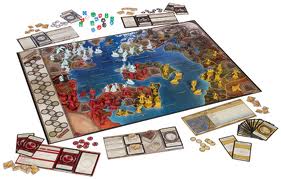Having just purchased and never played Conquest of Nerath, I would say I am in a good position to review it. Because, you know, I’ll be objective or something:
Basic Impression: Conquest of Nerath is your classic light to medium complexity war-game with a number of notable D&D themed twists! In terms of complexity, I would say it is notably more complex than Risk and a little less complex than Axis and Allies.
Cool Features: There are some notable features that distinguish Conquest of Nerath from other war games of it’s type.
- Treasure Cards: These add an interesting element to the game. Heroes (a type of unit) can explore dungeon spaces, where they battle powerful monsters. If they defeat them, they gain a treasure card, which generally gives a cool benefit that applies for the rest of the game (often specific to a particular unit) and one or more victory points towards winning the game. They also sometimes have a cool one off power. A number of classic D&D magic items are featured, such as the deck of many things, holy avenger, eye of vecna, and vorpal sword, all with appropriately cool effects. Treasure cards add an interesting dynamic to game: you want to capture your enemies territories while diverting some resources to explore dungeons and acquire treasure cards that give additional victory points and cool abilities.
- Event Cards: Each of the four sides has its own unique event deck. Each player draws from the deck at the beginning of their turn and either has to play the card immediately or can save it to aid them later, often in battle. This is a fun mechanic that distinguishes the different sides from each other, adds variety to game-play, and introduces another resource to manage.
- Thematic Units: While footsoldiers, siege engines, castles, and warships are pretty standard medieval fare, some of the other units have a fun D&D/fantasy feel to them. Only heroes (wizards and fighters) can enter dungeons, monsters have a fun “Run Amok” power where they terrorize and conquer an adjacent enemy territory after a successful battle, storm elementals are twice as good at attacking when on sea, and the dragon takes more than one hit to kill and has a super high attack die.
Further Thoughts:
- Shared Victory: There is a team mode that doesn’t exactly blow me away, since it seems pretty similar to just playing a two player game (though I suppose the cards are hidden information, so that could make for some fun moments as your partner steps in to help you during battles).
- Rewards Aggression: The game has 3 modes (short, medium, and long), and the first two involve acquiring a number of victory points. Interestingly, you get these for conquering territories, but you don’t lose points for losing territories or gain points for recapturing your own territories! So it seems like a good strategy is to aggressively take other player’s territories, while caring less about protecting or retaking your own territories (though you never want to lose your capital, since that has pretty serious repercussions).
In short, Conquest of Nerath looks like it will be pretty fun to play. It has relatively simple rules, so I imagine it won’t be too difficult to find an opportunity to get a game together.









Interesting. The “rewards agression” point sounds like it will be “Race to Switch Sides”.
Does the dungeon exploration take place on a map, or is it an abstract card drawing thing?
Simpler than Descent?
Yes, the victory point system is the bit for which I am most suspicious, since it seems like you could collude with another player to rack up points by giving up each others territories and that sort of thing.
The dungeon exploration is handled like a normal battle, pretty much, so very abstract. You roll dice for your heroes, and the monster rolls one or more dice depending on how strong it is. Then you assign damage. You either retreat or keep fighting until the heroes or the monster is dead.
I’m curious to hear what you thought about the quality of all the stuff in the box. Were the pieces of pretty high quality?
The components are reasonably high quality. The plastic playing pieces are fine, though a little lower chintzier than the Ravenloft and Ashardalon minis, which were basically D&D minis (these aren’t). The board is very nice. And the other components are decent quality cardboard and card-stock. It also comes with a bunch of dice of different types.
I’ve played Conquest and the Victory Points situation isn’t an issue. You don’t gain points for reclaiming a territory that belongs to you (or an ally), and if you’re not allied and you just trade locations back and forth, than only one of you is going to win (and also the other two players will easily benefit at the same time.
Dungeon exploration is not on a map or anything, just represented by one ore more creature cards that stack up on the dungeon.
Makes sense. Dungeon exploration on a separate map would be problematic (what would the other players do while you were spelunking?) but SUPER FUN. I’m put in mind of By Jove, the Greek-themed Monopoly clone that had a labyrinth exploration minigame in the center of the board.
I really enjoy reading through on this web site , it holds superb content . “Words are, of course, the most powerful drug used by mankind.” by Rudyard Kipling.